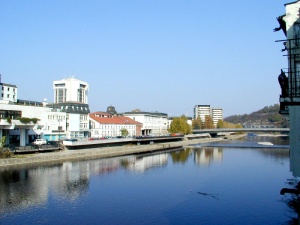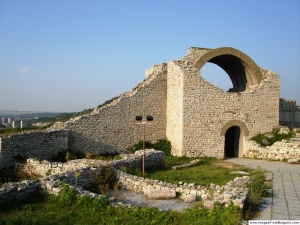Information about the town of Lovech
Lovech PropertiesThe town of Lovech has 44 262 inhabitants and is about 200 metres above sea level. It is picturesquely situated along the two banks of the Osum River, where the last elevations of the Pre-Balkan Mountain end. It is situated at the distance of about 170 km to the north-east of Sofia, 90 km and 35 km to the south, of Nikopol and Pleven, respectively, at the distance of 35 km to the north of Troyan, 86 km to the west of Veliko Turnovo and 65 km to the north-west of Gabrovo. One of the oldest and most interesting Bulgarian towns. A regional administrative centre.
History: The town is a descendant of the Thracian by-the-road town of Melta (in today’s area of Hissarluka) which had a strategic location along the Danube-Aegean Sea main road. During the Medieval times the town remained an important military strategic centre and it was called Lovuts (a town of hunters) by the 11th century. During the 12th century it was moved to the right bank of the Osum River where the quarter of Varosha is situated now. After the Turnovo Uprising the Lo-vech Fortress firmly defended the approaches to Turnovo and after a 3-month siege the Byzantine Empire was forced to conclude the well-known Lovech Peace Treaty (1187), stipulating a new beginning for the Bulgarian state. Since the end of the Byzantine domination the town has been known by its today’s name - Lovech.
During the 13th and particularly during the 14th century it was one of the biggest towns and fortresses in Northern Bulgaria and it reached an enviable economic prosperity. The town fell under Ottoman Rule in 1393. The last semi-independent ruler of the Lovech Fortress - Stanko Kussam, became a haidoutin (rebel) after its downfall. In the first centuries of Ottoman Rule the town declined and it was not until the 18th and particularly during the 19th century that it became well off, thanks to crafts and trade. It was called Altun Lovech (Golden Lovech). In 1870 the town had 11 thousand inhabitants. As early as in 1839 the struggle for an independent Bulgarian church began here. The first schools were opened in 1846-1847 and one of the first teachers here was the people’s poet and writer Petko R. Slaveikov. In 1870 a chitalishte (community cultural centre and reading-room) was established here and two years later the first theatrical performance was held under the guidance of Angel Kunchev.
There was an old covered wooden bridge over the Osum River but the river carried it away in 1872. Only 2 years after that the self-studied master of genius craftsman master usta Kolyu Ficheto built up his famous covered bridge with 24 small workshops in it. Unfortunately it was burned to ashes by a fire in 1925. The present (unique in the country) covered bridge was built up on the analogy of it. During the years of the national liberation movement (the second half of the 19th century) Lovech turned into the revolutionary capital of Bulgaria. In 1869 Vassil Levski laid the foundations of the local revolutionary committee and in the following year he pointed Lovech as a centre of the Internal Revolutionary Organisation. It was from here on that the fibres entwining all the country started and they rose the Bulgarian people in battle for national independence. On 17th July 1877 Lo-vech was liberated by the squadron of Col. Zhe-rebkov and Col. Parensov but 10 days later the Turks conquered it again and slaughtered over 2500 Bulgarians in the town and in its surroundings. The town was finally liberated on 3rd September 1877 by the units of Gen. Imeretinski, Gen. Sko-be-lev and Gen. Dobrovolski. Its freedom was won at the price of 1683 Russian victims.
After the Liberation Lovech loses the markets in the Ottoman Empire. The construction of the railway line Levski - Lovech (1932) and its extension to Troyan (1948) gave an impetus in the development of the town. For the last few years the town has established itself as a big cultural and tourist centre.
Landmarks: Varosha Architecture-Historical Reserve - the old quarter of the town, amphitheatrically situated along the right bank of the Osum River. Over 160 houses of the characteristic Revival architecture were restored in it. The houses along the street leading to the Stratesh Park are particularly outlined. The following places of interest are located in the Varosha quartert: The Revival and the National Liberation Movement Museum also known as Vassil Levski Museum (14, Marin Pop Loukanov), which is located in a special building constructed on the place where the house of Levski’s follower Marin Pop Lukanov was. The old square with the monument to Todor Kirkov (an outstanding national revolutionary from Lovech hanged by the Turks in 1876) is situated along the river. The house-museum of Ivan Drassov - a follower and councellor of Levski (Marin Pop Lukanov Street). Cheshneto House. Rasho’s House. The Hristo Tsonev-Latinetsa House-Museum, owner of Kukrinsko Hanche (Kukrina’s Inn). His house gave shelter to Vassil Levski. The Art Gallery (9, Vassil Levski Street).
The famous covered bridge (built by Usta Kolyu Ficheto) links Varosha with the remaining part of the town. It is a pedestrian area with shops on both sides. The ancient Holy Virgin Church. The monument to Vassil Levski (above the southern end of the town). The white and the black monuments are dedicated to the Russian liberators of Lovech (in the Stratesh Park). It is a real pleasure to walk along the little, steep and narrow streets of old Varosh.
The Stratesh Park - in the eastern part, on the right bank of the Ossum River, is a wonderful place for recreation, located in a picturesque countryside with a well-developed tourist infrastructure and a zoo. There are a lot of monuments and ruins of a Medieval Bulgarian Fortress. The Park is also known as the Lilac Park due to the great number of this vegetative species attracting thousands of admirers of its tender blossoms and irresistible fragrance. Lilac Days of Music are held in Lovech during May every year.
Accommodation: The Lovech Hotel. The Orbita-2 Hotel (2-star, in the Varosha Quarter). The Hissarya Hotel. Stratesh Tourist House (in the Stratesh Park, 66 beds in two suites and rooms with 2 and 3 beds). Bash Bounar Tourist Hostel (a 30-minute walk from the centre into the direction of Troyan, in the Presechena Skala area (Cut Rock), it may be reached with the town transport, too and a 10-minute walk, 74 beds in rooms with 3, 4 and more beds).
Transport. There are regular bus lines to Sofia, Pleven, Troyan, Teteven, Sevlievo, Gabrovo, Veliko Turnovo, Levski and other smaller settlements within the region. The bus station and the railway station are located not far from each other in the western part of the town. Lovech is a transitional station of the railway line Levski - Troyan, linking it to the national railway network. There is a town bus transport functioning in Lovech.
Surrounding areas: The Bash Bounar Park is located in the immediate proximity of the town, on the way out to Troyan. There are a lot of small and big caves in the rocky banks of the Ossum River. Bones and tools from the Paleolithic period and the Bronze Era were found in two of them - Vassil Levski Cave and The Tabash-ka Cave. One can get to the park on foot from the centre of the town in less than an hour. There is a town bus, too.
In the village of Stefanovo, 20 km south-east from Lovech and 27 km north-east from Troyan is the village of Staro Stefanovo Architecture Reserve (the only one on the territory of the region) with over 100 monuments of culture from the beginning and the middle of the 19th century. The first written information dates back to 1515 from the registers of Nikopol sandzhak (district) when the village was called Isvote. Other sources are the taxation records (1624) and Voinugan lists from the beginning of the 18th century. Preserved as an entire ethnographical complex, the village of Stefanovo (until 1949 - Vratsa) during the Ottoman Rule enjoyed the status of a soldiers’ and dervishko (Turkish monks) village. One of the oldest settlements in the Lovech district with a proven ancient Bulgarian origin. Sites of interest are also the Birth of the Holy Virgin Church built in 1864 by Usta (Master) Gencho Kunchev from Tryavna; Selskata Cheshma (the village drinking-fountain) (1830); Popovoto Bridge (1824) built by Master Marin Hristov from Lovech; the old Tser (Oak tree) - over 1300 years old - around which were the grounds for spiritual services. The first school was set up in 1854 in the house of Priest David – Father Superior in the Troyan Monastery up to 1906, follower and a courier of the Apostle Vassil Levski. In 1870 a secret revolutionary committee was founded and often the Apostle and Priest Matei Preobrazhenski - Mitkaloto (the Wanderer) visited the village. A native rebel is Ivanaki Yonkov Kyurkchiyata – Vrachancheto, who was among the leaders of the Velchova Zavera (Velcho’s Conspiracy against the Ottoman Rule), hung by the Turks in 1836. In the village there is a tourist hostel offering 20 beds. Private lodgings are available at the Dzhurov’s, Georgiev’s and Hadzhi Minkov’s houses, the last one hosting a rich private ethnographic exhibition. In the area there is an ancient Roman fortress - Kaleto and some Thracian mounds. The village is a favourite place for shooting film productions for its preserved distinctive spirit and architecture. There is a regular bus from Lovech.
The Kukrinsko Hanche (Kakrina’s Inn) Museum is located in the village of Kukrina, at the distance of 17 km to the east of Lovech. After the treachery of Pop Krustyo (Krustyo Priest), on 26th December 1872 the Apostle of Bulgarian Freedom Vassil Levski was captured here.
Lovech Properties

